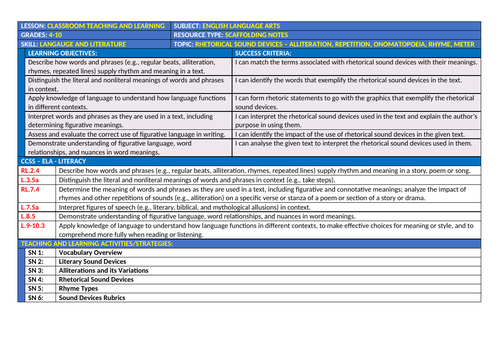




This compact review of rhetorical sound devices for quick referencing is perfect for teaching Rhetorical Sound Devices – Alliteration, Assonance, Consonance, Sibilance, Onomatopoeia, Repetition, Rhyme and Meter. These no prep scaffolding notes would be great for ELA lessons or ELA centers. You and your students will love this information that is well planned for student engagement.
After reading this information students will be able to:
- Match the terms associated with rhetorical sound devices with their meanings.
- Identify the words that exemplify the rhetorical sound devices in the text.
- Form rhetoric statements to go with the graphics that exemplify the rhetorical sound devices.
- Interpret the rhetorical sound devices used in the text and explain the author’s purpose in using them.
- Identify the impact of the use of rhetorical sound devices in the given text.
- Analyse the given text to interpret the rhetorical sound devices used in them.
This Download Includes:
- SN 1: Vocabulary Overview
- SN 2: Literary Sound Devices
- SN 3: Alliterations and its Variations
- SN 4: Rhetorical Sound Devices
- SN 5: Rhyme Types
- SN 6: Sound Devices Rubrics
Here are some other possible uses for these in your classroom:
- To challenge early finishers
- For effective tutoring
- As ESL stations and sub tubs
- As holiday work and homework
- For small group collaborations
- For an end of unit assessments
- For reinforcement and enrichment
Get this resource as part of a bundle and save up to 50%
A bundle is a package of resources grouped together to teach a particular topic, or a series of lessons, in one place.
SOUND DEVICES - ALLITERATION ONOMATOPOEIA REPETITION RHYME METER: BUNDLE
These bundled resources are perfect for teaching Rhetorical Sound Devices - Alliteration, Assonance, Consonance, Sibilance, Onomatopoeia, Repetition, Rhyme and Meter. These no prep activities would be great for English lessons or English centers. Your students will love these ELA Boom Cards, Google Slides, PPT, Unit Plans, Worksheets and scaffolding notes. After attempting these New Bloom’s Taxonomy based activities students will be able to: * Match the terms associated with rhetorical sound devices with their meanings. * Identify the words that exemplify the rhetorical sound devices in the text. * Form rhetoric statements to go with the graphics that exemplify the rhetorical sound devices. * Interpret the rhetorical sound devices used in the text and explain the author’s purpose in using them. * Identify the impact of the use of rhetorical sound devices in the given text. * Analyse the given text to interpret the rhetorical sound devices used in them. This download includes: * Scaffolding Notes: 6 Handouts * Worksheets with Answers: 35 Exercises * Unit Lesson Plan: 41 Pages * PowerPoint Presentation: 43 Slides * Google Slides: 43 Slides * Boom Cards: 96 Digital Task Cards Here are some possible uses for these in your classroom: * To challenge early finishers * For effective tutoring * As ESL stations and sub tubs * As holiday work and homework * For small group collaborations * For an end of unit assessments * For reinforcement and enrichment ◈◈◈◈◈◈◈◈◈◈◈◈◈◈◈◈◈◈◈◈◈◈◈◈◈◈◈ Save 50% on this BUNDLE! Note: These are also sold separately! ◈◈◈◈◈◈◈◈◈◈◈◈◈◈◈◈◈◈◈◈◈◈◈◈◈◈◈
FIGURATIVE LANGUAGE HANDOUTS BUNDLE
This bundle of 10 products (Scaffolding Notes) is perfect for teaching Figures of Speech - Simile, Metaphor, Hyperbole, Analogy, Personification, Sensory Imagery, Irony, Synecdoche, Metonymy, Alliteration, Onomatopoeia, Repetition, Rhyme and Idioms. These no prep activities would be great for ELA lessons or ELA centers. Your students will love these exercises that are planned for student engagement. After studying this information, students will be able to: * Define various figures of speech with examples. * Compare and contrast various figures of speech. * Examine the examples of various figures of speech to identify their meaning. * Interpret a given text and identify the examples of various figures of speech. * Evaluate a text and explain how various figures of speech have impact on the reader. * Use figures of speech to make writing poetic and to express creatively and concisely. This bundle includes Scaffolding Notes on: * Rhetorical Comparison Devices: 6 Handouts * Rhetorical Sound Devices: 6 Handouts * Sensory Imagery – Word Images: 4 Handouts * Personification – Figure of Speech: 5 Handouts * Irony Types – Verbal, Situational, Dramatic: 6 Handouts * Synecdoche vs Metonymy: 11 Handouts * Oxymoron: 3 Handouts * Elegy: 3 Handouts * Simile: 7 Handouts * Metaphor: 6 Handouts Here are some other possible uses for these in your classroom: * To challenge early finishers * For effective tutoring * As ESL stations and sub tubs * As holiday work and homework * For small group collaborations * For an end of unit assessments * For reinforcement and enrichment ◈◈◈◈◈◈◈◈◈◈◈◈◈◈◈◈◈◈◈◈◈◈◈ Save 50% on this BUNDLE! Note: These are also sold separately! ◈◈◈◈◈◈◈◈◈◈◈◈◈◈◈◈◈◈◈◈◈◈◈
Something went wrong, please try again later.
Excellent!!
Report this resourceto let us know if it violates our terms and conditions.
Our customer service team will review your report and will be in touch.